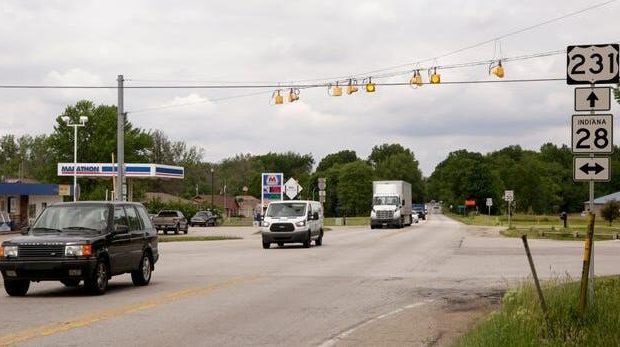WEST LAFAYETTE - An invention by Purdue University and the Indiana Department of Transportation uses wireless communication at traffic intersections that will potentially save lives.
Principal research analyst Howell Li and transportation research engineer Jijo Mathew of the Joint Transportation Research Program in Purdue University's Lyles School of Civil Engineering have collaborated with INDOT to further improve the safety of vehicles as they approach a signalized intersection, a release from Purdue says.
"According to the Federal Highway Administration, 2 million crashes occur annually at intersections with traffic signals," the release states, "leading to hundreds of thousands of injuries and more than 3,000 fatalities."
Mathew stated that drivers' decisions to stop or continue at a traffic signal is made once the light has turned yellow. Once drivers hit the "dilemma zone" while approaching an intersection, drivers can neither stop safely nor clear the intersection safely at its present speed.
"To reduce crashes, the key idea is to provide dilemma-zone protection," Mathew said in the release. "One would think yellow time can be extended; however, drivers tend to adapt to this, resulting in lower probabilities of stopping.
"The state-of-the-practice for actuated intersections - intersections where timing is influenced by sensors - is to use green extensions, where the green time is extended for a certain period when a vehicle is present. Although this reduces the exposure of vehicles to the onset of yellow, this can go only for so long."
This Purdue-INDOT technology can extend green-time or indicate yellow-time as early as necessary to ensure intersection safety on a 0.1-second basis, according to the release.
The system considers the trajectory of each vehicle relative to a predetermined time of when the green would end, the release states. If there is enough time the spare, the green will be extended until vehicles clear the intersection.
If there are other vehicles competing for green time on other movements, the system will indicate yellow early before the vehicle enters the dilemma zone to allow for a safe stop.
Li stated in the article that this innovation improves traditional technology that extends greenlight signals in multiple ways.
"Infrastructure sensors have a fixed range, are expensive, may require intrusive installation on existing infrastructure, and need routine maintenance to ensure proper operation," Li said. "And most sensors do not detect vehicles continuously one mile away to adjust timing changes, such as when the onset of yellow occurs."
Purdue lists a YouTube video in the article that features Li further explaining how this technology works.
A wireless communication device is placed at traffic signals and in vehicles, and specialized control logic at the signal controller brings it all together, the release states.
"Vehicles are already rolling off the assembly lines with built-in communication devices in the form of cellular," Li said. "High-bandwidth, low-latency technologies such as 5G and beyond are being more widely adopted around the country and the world.
"Compelling use cases such as reducing yellow- and red-light incursions for heavy vehicles and the safety data to support the findings will accelerate adoption by transportation agencies, I believe."
This technology was testing over a week at County Road 500 S. at U.S. Highway 231 in Tippecanoe County. The remaining data for benefit estimation was simulated.
"During my time working at the Indiana Department of Transportation, I have only been aware of conceptual-use cases involving onboard vehicle communication technology integrating with live traffic signal control," Tom Platte, with the Indiana Department of Transportation, said. "Our new technology moves this integration beyond the merely conceptual. This work provides an implemented real-world use case that addresses an important safety concern, among other applications."








Gloss